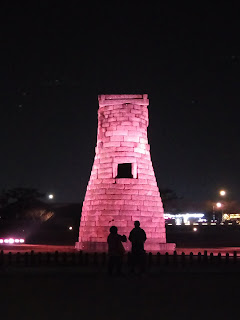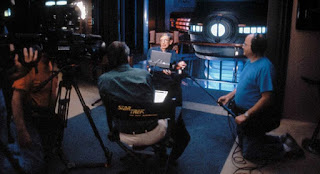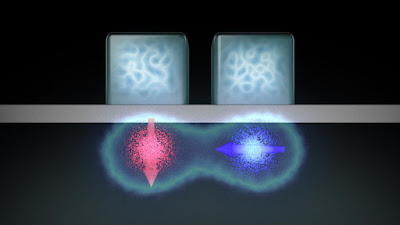All Posts (6509)
 |
| The Tower of the Moon and the Stars, an observatory built by Queen Sonduk, after she came to power in 632 CE. Credit: GABRIELLA BERNARDI |
Topics: Astronomy, Astrophysics, History, Diversity in Science, Women in Science
Will I ever know the truth about the stars?
I’m too young to engage in theories about our Universe.
I just know that I want to understand more. I want to know all
I can. Why should it be forbidden?
The unforgotten sisters: Sonduk, the astronomer queen, Gabriella Bernardi, Cosmos Magazine
In the first of a three-part series, Italian science writer Gabriella Bernardi profiles a seventh century Korean astronomy pioneer.
Topics: Astronomy, Astrophysics, Cosmology, Dark Matter, Theoretical Physics
*****
1. Astrophysicists Claim They Found a 'Galaxy Without Dark Matter', Rafi Letzter, Live Science
2. Found: a galaxy devoid of dark matter, Richard A Lovett, Cosmos Magazine
 |
| "The new battery design protects the lithium metal anode with a coating of lithium carbonate. That allows lithium ions from the anode to enter the electrolyte while keeping unwanted compounds from reaching the anode. It’s easy to create this protective layer, too. The researchers just had to run a few charge-discharge cycles with a pure carbon dioxide atmosphere, and a crystal mesh of lithium carbonate accumulated." Extreme Tech |
Topics: Alternative Energy, Green Energy, Green Tech, Solar Power
Out Of thin air, Joe Harmon, Argonne National Laboratory
 |
| Tiangong-1 altitude decay forecast as of March 22, 2018. |
Topics: ESA, NASA, Space Exploration
A Fiery End - Chinese space station will fall to Earth within two weeks
Eric Berger, Ars Technica
#P4TC: Tiangong, Tentatively... April 30, 2011
 |
| Image Source: Link below |
Topics: Atomic Physics, Quantum Computer, Quantum Mechanics, Nanotechnology
Scientists unveil high-sensitivity 3-D technique using single-atom measurements, Griffith University
Graphic Justice is a blog that covers/studies legality and justice within comics and the comic industry. They run conventions and submit academic papers on topics related to comics every year.
They are always looking for submissions, and so I've decided to submit a legal concept article to their site. In my first book Super Humanity, the characters face a tribunal because they executed a prisoner during the Battle of Cleveland. They won because of legal technicalities.
If you've ever wanted to write about comics and legalese together, now's your chance.
You can find submission guidelines at the link here.
 |
| Image Source: wiseGEEK |
Topics: Civics, Existentialism, History, Politics
 |
| Image Source: Learning-Mind.com/malignant-narcissist |
Topics: Commentary, Existentialism, Politics
*****
*****
More Concept Artistry from the BLACK PANTHER MOVIE as done by Concept Artist Marco Nelor..... enjoy
http://africandigitalart.com/2018/02/jabari-tribe-concept-art-and-character-designs/
More 3D digital art from Till Nowak shown at WePresent.com
https://wepresent.wetransfer.com/story/till-nowak-black-panther/
ENJOY
 |
| Credit: NASA, ESA; D. Coe; J. Anderson; R. van der Marel (STScI) |
Topics: Astrophysics, Black Holes, Cosmology, General Relativity, Quantum Gravity
Black Hole Pretenders Could Really Be Bizarre Quantum Stars, Charles Q. Choi, Scientific American
Topics: Commentary, Civics, Civil Rights, Existentialism, Politics
| Type | Muzzle Velocity | Web Links |
|---|---|---|
| 38 pistol | 830 | http://www.ballistics101.com/9mm_vs_.38special.php |
| 9-mm | 1150 | http://www.ballistics101.com/9mm_vs_.38special.php |
| M-16 | 2900 | http://www.answers.com/Q/What_is_the_muzzle_velocity_for_the_m4_carbine |
| AR-15 | 3241 | http://www.epicwilderness.com/best-223-remington-review-ar-15-ammunition/ |
| 25-06 Deer | 3440 | https://gunnewsdaily.com/best-caliber-for-deer-hunting/ |
Related links:
A generation raised on gun violence sends a clear message to adults: Enough is enough, Holly Yan and Emanuella Grinberg, CNN
Brittany Packnett: This is how we talk about the black victims of gun violence in America, Anthony Smith, MIC
ALABAMA 2-YEAR-OLD KILLS HIS 1-YEAR-OLD BROTHER IN ACCIDENTAL SHOOTING, Ryan Sit, Newsweek (13 March 18)
Three Accidental School Shootings in One Week — the Latest by a Teacher in a Gun Safety Class, Mark Keierleber, The 74 Million (14 March 18)
 |
| Poker with Data, Einstein, Hawking, and Sir Isaac Newton on the Holodeck |
 |
| Filming the scene with Professor Hawking |
 |
| Images from Star Trek tribute to Professor Hawking |
Topics: Physics, Physics and Pop Culture, Star Trek, Stephen Hawking
BBC: Stephen Hawking: Visionary physicist dies aged 76
Nature: Stephen Hawking (1942–2018)
Topics: Computer Science, Quantum Computer, Quantum Mechanics
Silicon qubits show promise for quantum computers, Belle Dumé, Nanotechweb.org
CONTACT ME: I am seeking Reviewers. Free Book will be shipped to you.
Historical Bureau of Investigation Agents Tad Jones and Kim Davis research history with
The Time Telescope in order to reconnect with their history due to the Great Cataclysm.
They discover individuals such as Sybil Ludington, Squanto and Crispus Attucks and more.
But what happens when they are TRAPPED in the past.
Will they ever return to the 23rd Century?
History and Science meet at The Time Telescope.
https://www.facebook.com/thetimetelescope/
https://www.youtube.com/watch?v=JQHJ5T-qLZw
The Graphic Novel and Ebook will be available on June 1st 2018 thru
Amazon, Indyplanet and Comixology.
I have been on a site called Wattpad for almost a year now. I like that this website is for undiscovered writers.
I currently have four stories on here. One has a ghost in it, two have Mermaids and one also includes werewolves and witches.
I feel a little odd writing about witches, as I have never seen any African American Wiccans or witches for that matter. I guess they are out there just like the rest of the supernaturals. I keep running into brief spells of writers block and then suddenly I get an idea.
I have been trying to learn how to finish my ideas instead of stopping and starting again. My main thing with Wattpad is that while I have about 17 followers, only two commented. I use the feedback I get to revise my stories, if I don't get anything then I end up unpublishing the story.
Aside from that I enjoy it. My daughter is a writer on there too.
